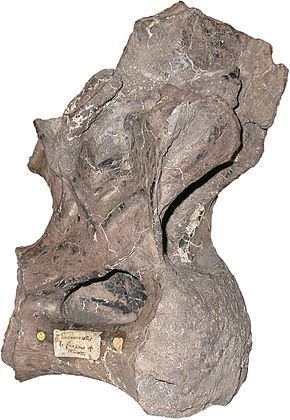Clade †Neosauropoda Phylum Chordata | Class Reptilia Rank Genus | |
 | ||
Similar Ornithopsis, Chondrosteosaurus, Pelorosaurus, Betasuchus, Anoplosaurus | ||
Eucamerotus (meaning "well-chambered" in reference to the hollows of the vertebrae) was a genus of sauropod dinosaur from the Barremian-age Lower Cretaceous Wessex Formation (Wealden) of the Isle of Wight, England. It is known from vertebral remains, and a partial skeleton has been referred, although this has not been accepted.
Contents
History and taxonomy
John Hulke named the genus from several partial dorsal vertebrae found by William D. Fox near Brighstone Bay: NHMUK R2522 (a neural arch), and NHMUK R88, NHMUK R89, NHMUK R90 (two dorsal vertebrae), and NHMUK R2524 (a dorsal from a juvenile). He did not provide it with a species name nor select a holotype, and within a few years thought that it was the same as Ornithopsis hulkei. Other authors preferred Pelorosaurus as a synonym.
William T. Blows resurrected the genus in 1995 as a valid brachiosaurid, added the specific name foxi, selected BMNH R2522 as the type specimen, designated the other finds as paratypes and referred additional vertebrae and partial skeleton MIWG-BP001 to it. This last point has not been generally accepted; unfortunately, this skeleton has never been officially described.
Naish and Martill (2001) suggested Eucamerotus was a dubious brachiosaurid, and did not find Blows' characters convincing. Upchurch et al. (2004) considered it to be a dubious sauropod. Santucci and Bertini (2005), however, suggested it was a titanosaurian. However, a recent review of Wealden sauropods from the UK places Eucamerotus at Titanosauriformes incertae sedis.
Paleobiology
The vertebrae are around twenty centimetres long. If a brachiosaurid, Eucamerotus may have been around 15 m (49.2 ft) long, small for a sauropod. As any kind of sauropod, it would have been a quadrupedal herbivore.
